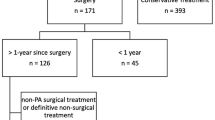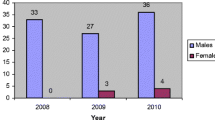Abstract
Background
Popularity in cycling continues to grow. In Ireland, in the last 5 years, 42% more people now use it to travel to work. This has been mirrored by a rise in cycling-related trauma and deaths. The popularity amongst men has led to the term middle-aged men in Lycra (MAMIL) being coined.
Aims
The purpose of our study was to quantify cycling-related pelvic and acetabular fracture referrals in Ireland and determine injury patterns, cost and functional outcomes following these injuries.
Methods
A retrospective cohort study was conducted of all referrals to our institution, the National Centre for Pelvis and Acetabular Fracture Management, in 2016 and 2017. Demographic, mechanism of injury, concomitant trauma and treatment data were analysed. Patients were contacted to assess return to work, sport and quality of life (EQ-5D-3L).
Results
Cycling injury referrals increased by 90% between 2016 and 2017 with a greater number of cycling than motorbike injury referrals. Twenty-nine patients sustained a pelvic and acetabular (PA) injury while cycling. The mean patient age was 51.7 years of which 86.2% were male with 41% suffering a concomitant injury. Fourteen patients (48.3%) required surgery of which 60% have returned to cycling. Mean cost of treatment was €11,757. The median EQVAS was 80.
Conclusions
The rise in popularity of cycling has been mirrored by an increase in PA injuries and deaths. These injuries are associated with significant costs to the patient, hospital and society. Greater investment in safety and awareness is needed to protect this vulnerable group.


Similar content being viewed by others
References
Gansslen A, Pohlemann T, Paul C et al (1996) Epidemiology of pelvic ring injuries. Injury27:S-A 27:13–20
Court Brown CM, Caesar B (2006) Epidemiology of adult fractures: a review. Injury 37:691–697
Ragnarsson B, Jacobsson B (1992) Epidemiology of pelvic ring injuries in a Swedish county. Acta Orthop Scand 63(3):297–300
Prieto-alhambra D, Aviles FF, Judge A et al (2012) Burden of pelvis fracture: a population-based study of incidence, hospitalisation and mortality. Osteoporos Int 23(12):2797–2803
Laird A, Keating JF (2005) Acetabular fractures; a 16-year prospective epidemiological study. J Bone Joint Surg Br 87(7):969–973
Buller L, Lawrie CM, Vilella FE (2015) A growing problem: acetabular fractures in the elderly and the combined hip procedure. Orthop Clin North Am 46(2):212–225
Boudissa M, Francony F, Kerschbaumer G, Ruatti S, Milaire M, Merloz P, Tonetti J (2017) Epidemiology and treatment of acetabular fractures in a level-1 trauma centre: Retrospective study of 414 patients over 10 years. Orthop Traumatol Surg Res 103(3):335–339
Oja P, titze S, Baumen A et al (2011) Health benefits of cycling: a systematic review. Scan J Med Sci Sports 21(4):496–509
Fishman E, Schepers P, Kamphuis CB (2015) Dutch cycling: quantifying the health and related economic benefits. Am J Publin Health 105(8):e13–e15
Cycling UK. Surrey (England). Cycling UK cycling statistics 2018 https://www.cyclinguk.org/resources/cycling-uk-cycling-statistics. Accessed on 6 May 2018
Central Statistics Office (CSO) Ireland. Census of population 2016 – profile 6 commuting in Ireland. 2016. http://www.cso.ie/en/csolatestnews/presspages/2017/census2016profile6-commutinginireland/. Accessed on 6 May 2018
Oxford University Press. Oxford dictionaries. 2018. https://en.oxforddictionaries.com/definition/mamil. Accessed on 6 May 2018
Court-Brown CM, Allan M, Davidson E, McQueen MM (2013) The epidemiology of cycling fractures in adults. Emergency Med 3:139
Broe MP, Kelly JC, Groarke PJ, Synnott K, Morris S (2018) Cycling and spinal trauma: a worrying trend in referrals to a national spine centre. Surgeon 16(4):202–206
Road Safety Authority. Mayo (Ireland). Deaths on Irish roads 2018. 2018. http://www.rsa.ie/RSA/Road-Safety/Our-Research/Deaths-injuries-on-Irish-roads/. Accessed on 6 May 2018
Road Safety Authority. Mayo (Ireland). Cyclists. 2018. http://www.rsa.ie/RSA/Road-Safety/Campaigns/Current-road-safety-campaigns/Cyclists/. Accessed on 6 May 2018
Caulfield B (2014) Re-cycling a city—examining the growth of cycling in Dublin. Transp Res 61:216–226
Caulfield B, Leahy J (2011) Learning to cycle again; examining the benefits of providing tax-free loans to purchase new bicycles. Res in Trans Bus Manag 2:42–47
Glackin OF, Beale JT (2017) ‘The world is best experienced at 18 mph’. The psychological wellbeing effects of cycling in the countryside: an interpretative phenomenological analysis. Qual Res in Sport, Exercise and Health 10(1):32–46
Rector RS, Rogers R, Ruebel M, Hinton PS (2008) Participation in road cycling vs running is associated with lower bone mineral density in men. Metabolism 57(2):226–232
Scholten AC, Polinder S, Panneman MJ et al (2015) Incidence and cost of bicycle-related traumatic brain injuries in the Netherlands. Accid Anal Prev 81:51–60
Aitken SA, Watson BS, Wood AM, Court-Brown CM (2014) Sports-related fractures in South East Scotland: an analysis of 990 fractures. J Orthop Surg (Hong Kong) 22(3):313–317
Bass A, Lovell ME (1995) Two cases of acetabular fractures sustained during competitive cycling. Br J Sports Med 29(3):205–206
Keel MJ, Bastian JD, Buchler L et al (2010) Surgical dislocation of the hip for a locked traumatic posterior dislocation with associated femoral neck and acetabular fracture. J Bone Joint Surg Br 92(2):442–446
Department of Transport (United Kingdom). Personal injury accident statistics on public roads in Great Britain for 2016. 2017. https://assets.publishing.service.gov.uk/government/uploads/system/uploads/attachment_data/file/648081/rrcgb2016-01.pdf. Accessed on 6 May 2018
Foley J, Cronin J, Gheorghescu A, Chetrit D, Evoy D, Ryan J (2016) Cycling injuries presenting to an Irish emergency department. Ir Med J 109(6):418
Giannoudis PV, Grotz MR, Papakositidis C et al (2005) Operative treatment of displaced fractures of the acetabulum. A meta-analysis. J Bone Joint Surg Br 87(1):2–9
Acknowledgements
We would like to thank the orthopaedic and nursing staff of Frank’s Ward in helping maintain the database.
Author information
Authors and Affiliations
Corresponding author
Ethics declarations
Conflict of interest
The authors declare that they have no conflict of interest.
Research involving human participants
All procedures performed in this study involving human participants were in accordance with the ethical standards of the institution and with the 1964 Helsinki Declaration and its later amendments.
Informed consent
Informed consent was obtained from all individual participants in the study.
Rights and permissions
About this article
Cite this article
Fenelon, C., Murphy, E.P., Downey, C. et al. A growing problem: cycling referrals to the National Centre for Pelvic and Acetabular Fracture Management in Ireland. Ir J Med Sci 188, 855–859 (2019). https://doi.org/10.1007/s11845-018-1926-7
Received:
Accepted:
Published:
Issue Date:
DOI: https://doi.org/10.1007/s11845-018-1926-7




